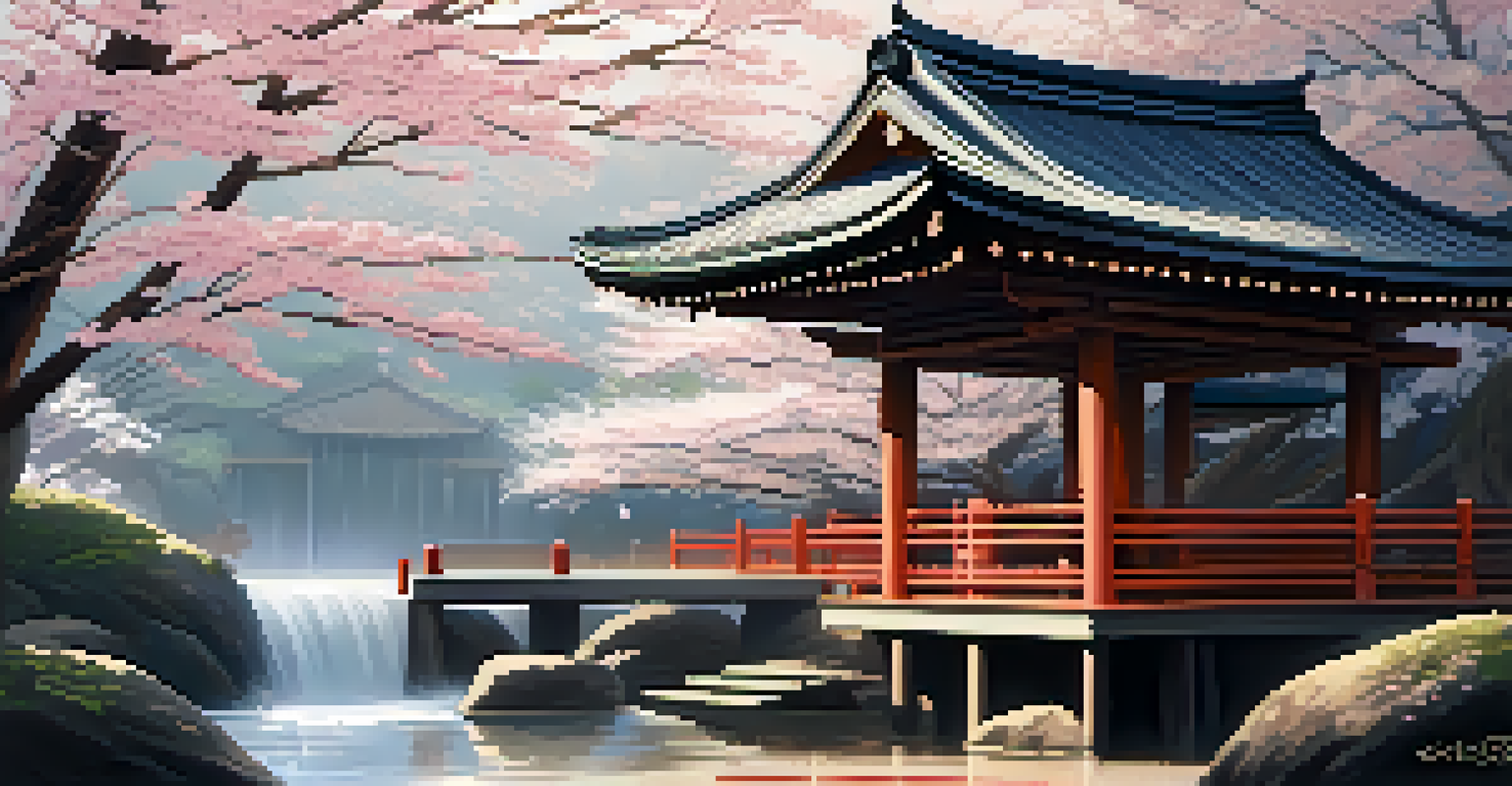The Evolution of Carving: From Prehistoric to Modern Times

Understanding the Origins of Carving in Prehistoric Times
Carving as an art form dates back to prehistoric times, where early humans used rudimentary tools to shape materials like wood and stone. These ancient carvings often served practical purposes, such as creating tools or weapons, but they also held cultural significance, reflected in the intricate designs found in cave art. For instance, the iconic Venus figurines from the Paleolithic era illustrate early humans' desire to express identity and beauty through carving.
Art is the most beautiful of all lies.
As communities evolved, so did their methods and materials. The discovery of sharper tools allowed for more detailed and intricate designs, leading to the creation of totems and ceremonial objects that reflected the beliefs and values of those societies. This transition marks the beginning of carving as not just a functional craft but also a form of storytelling.
In essence, these early carvings laid the groundwork for the artistic expressions that followed, with their influence echoing through the ages. Understanding these origins helps us appreciate the significance of carving beyond mere aesthetics, revealing it as a crucial aspect of human creativity and communication.
The Rise of Carving in Ancient Civilizations
As civilizations began to flourish, carving took on new dimensions, particularly in ancient cultures like Egypt, Mesopotamia, and Greece. These societies utilized carving to create grand monuments, intricate sculptures, and detailed bas-reliefs that celebrated their gods, rulers, and significant events. For example, the Great Sphinx of Giza is a testament to the skill and ambition of ancient Egyptian carvers, standing as an enduring symbol of their civilization.

Carving during this period was often a collaborative effort involving skilled artisans who passed down techniques through generations. This not only preserved the craft but also allowed for the development of distinct styles that reflected cultural values and traditions. The Greeks, for instance, perfected the technique of marble carving, creating lifelike figures that conveyed beauty and movement.
Carving's Historical Significance
Carving has evolved from practical tools and cultural expressions in prehistoric times to a revered art form in ancient civilizations.
This era marked a significant shift in the perception of carving—from a utilitarian craft to a revered art form. The stories told through these carvings provided insight into societal beliefs, showcasing how art can transcend time and continue to resonate with future generations.
The Influence of Religion on Carving Techniques
Throughout history, religion has played a pivotal role in the evolution of carving techniques. In medieval Europe, for instance, churches and cathedrals became canvases for intricate carvings that depicted biblical stories and saints. These carvings were not merely decorative; they served an educational purpose, helping the largely illiterate population understand religious narratives through visual storytelling.
Every artist dips his brush in his own soul, and paints his own nature into his pictures.
Similarly, in Asia, the intricate carvings found in temples and shrines reflect spiritual beliefs and practices that are deeply rooted in the culture. The craftsmanship involved in creating these religious artifacts demonstrates the dedication of artisans to their faith, often requiring years of training and practice to master the techniques. For example, the beautifully carved wooden sculptures in Hindu temples are not only artistic expressions but also embodiments of devotion.
This intertwining of religion and carving highlights how art can serve a higher purpose, acting as a bridge between the divine and the everyday. As artisans responded to the spiritual needs of their communities, carving evolved into a medium for expressing faith and cultural identity.
The Renaissance: A Turning Point in Carving Artistry
The Renaissance marked a transformative period in the world of carving, as artists began to break free from medieval constraints and embrace humanism. This new approach to art emphasized the importance of realism and individual expression, leading to remarkable advancements in carving techniques. Renowned sculptors like Michelangelo and Donatello redefined the craft, infusing their works with emotion and intricate detail.
One of the most famous examples is Michelangelo's 'David,' a masterpiece that showcases the artist's understanding of human anatomy and form. The level of detail in the marble carving not only displays technical skill but also captures the essence of human emotion, setting a new standard for future generations of artists. This period also saw an increased appreciation for the artist as an individual creator, rather than just a craftsman.
Religious Influence on Carving
Throughout history, religious beliefs have shaped carving techniques, turning them into educational tools for storytelling and cultural identity.
As carving evolved during the Renaissance, it began to reflect broader cultural shifts, including the appreciation for beauty and the exploration of human experience. This era solidified carving as a significant art form, influencing countless artists and paving the way for future innovations in sculpture.
Exploring Carving Techniques in Different Cultures
As carving spread across the globe, various cultures developed unique techniques that reflected their values and environments. For instance, Indigenous peoples in North America used carving to create totem poles, which served as both artistic expressions and historical records of their clans. These towering structures, adorned with intricate figures and symbols, convey stories that are vital to their cultural heritage.
In contrast, Japanese woodblock carving, known as ukiyo-e, emphasizes elegance and simplicity, capturing the beauty of nature and everyday life. This technique requires meticulous attention to detail and has influenced various art movements worldwide. The serene landscapes and graceful figures depicted in ukiyo-e prints showcase the harmony between craftsmanship and artistic vision.
These diverse carving traditions illustrate how different cultures interpret and utilize the art form, enriching the global tapestry of artistic expression. By exploring these various techniques, we gain a deeper appreciation for the skill and creativity that carving embodies across different societies.
The Role of Technology in Modern Carving Practices
In the contemporary world, technology has revolutionized the art of carving, leading to new methods and materials that were previously unimaginable. CNC (Computer Numerical Control) machines, for example, allow artists to create intricate designs with precision, pushing the boundaries of traditional carving techniques. This technology enables both professionals and hobbyists to experiment with complex patterns and shapes that would be challenging to achieve by hand.
Furthermore, advancements in tools such as laser cutters have opened up possibilities for creating detailed carvings on various materials, including metal and glass. Artists can now produce stunning works that blend traditional craftsmanship with modern innovation, resulting in unique pieces that resonate with today’s audiences. This fusion of old and new reflects a dynamic approach to carving, where the essence of the art form is preserved while embracing contemporary advancements.
Modern Carving as Personal Expression
Today, carving serves as a dynamic medium for personal expression and social commentary, challenging traditional boundaries and inviting deeper engagement.
However, this evolution also raises questions about the authenticity and value of handcrafted versus machine-made art. As technology continues to shape the landscape of carving, artists must navigate these changes, finding ways to maintain the integrity of their craft while exploring new creative avenues.
Carving as a Form of Personal Expression in Modern Art
Today, carving is not just about creating traditional sculptures; it has evolved into a powerful medium for personal expression and social commentary. Modern artists are using carving to explore themes such as identity, culture, and the human experience, often pushing the boundaries of what carving can signify. This shift has led to innovative works that challenge conventions and invite viewers to engage with the art on a deeper level.
For example, contemporary sculptors like Anish Kapoor and Damien Hirst incorporate carving into their installations, using it as a means to provoke thought and evoke emotion. Their works often reflect societal issues, encouraging conversations about everything from materialism to the fragility of existence. This evolution showcases how carving can transcend its traditional roots, evolving into a platform for dialogue and reflection.

As artists continue to redefine the boundaries of carving, it remains a vibrant and relevant form of artistic expression in the modern world. By embracing both traditional techniques and contemporary themes, carving is poised to inspire future generations, ensuring its place in the ever-evolving landscape of art.